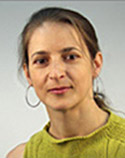Research Focus
The aim of our research group is to investigate the relevance of deregulation of alternative splicing in tumour progression. As a model system we use the Ron gene that encodes a member of the scatter factor receptor family. Ron lies at the starting point of a signal transduction cascade eliciting invasive growth and protection from apoptosis. Deregulation of the splicing programme of Ron transcripts frequently occurs in tumours and is associated with metastasis.
We have recently shown that splicing factor SF2/ASF controls the splicing pattern of the Ron gene transcripts. Because of this property SF2/ASF has a critical role in controlling cell motility and the epithelial to mesenchimal transition. Another aspect we are interested in concerns the possible role of physical and chemical stress on alternative splicing, particularly in view of the fact that cancer cells frequently experience stressing conditions, such as hypoxia.
In this regard, we have found that treatments that trigger the heat shock response induce the transcriptional activation of heterochromatic portions of the genome consisting of arrays of Satellite III DNA repeats. SatIII RNAs remain associated with sites of transcription and sequester a subset of pre-mRNA processing factors, among which SF2/ASF. SatIII RNA may viewed as natural decoys and their expression may represent a novel mechanism to control pre-mRNA splicing by redirecting the sub-cellular distribution of splicing factors.
Publications
- Ghigna, C., De Toledo, M., Bonomi, S., Valacca, C., Gallo, S., Apicella, M., Eperon, I., Tazi, J. and Biamonti, G. (2010). Pro-metastatic splicing of Ron proto-oncogene mRNA can be reversed: Therapeutic potential of bifunctional oligonucleotides and indole derivatives. RNA Biology 7(4), [Epub ahead of print].
- Lee, Y.B., Colley, S., Norman, M., Biamonti, G., Uney, J.B. (2007). SAFB re-distribution marks steps of the apoptotic process. Experimental Cell Research 313, 3914-3923.
- Falaschi, A., Abdurashidova, G., Sandoval, O., Radulescu, S., Biamonti, G., Riva, S. (2007). Molecular and structural transactions at human DNA replication origins. Cell Cycle 6, 1705-1712.
- Abdurashidova, G., Radulescu, S., Sandoval, O., Zahariev, S., Danailov, M.B., Demidovich, A., Santamaria, L., Biamonti, G., Riva, S., Falaschi, A. (2007). Functional interactions of DNA topoisomerases with a human replication origin. EMBO Journal 26, 998-1009.
- Valgardsdottir, R., Chiodi, I., Giordano, M., Cobianchi, F., Riva, S., and Biamonti, G. (2005). Structural and functional characterization of noncoding repetitive RNAs transcribed in stressed human cells. Molecular and Cellular Biology 16, 2597-2604.
- Ghigna, C., Giordano, S., Shen, H., Benvenuto, F., Castiglioni, F., Comoglio, P. M., Green, M. R., Riva, S., and Biamonti, G. (2005). Cell Motility Is Controlled by SF2/ASF through Alternative Splicing of the Ron Protooncogene. Molecular Cell 20, 881-890.
- Rizzi, N., Denegri, M., Chiodi, I., Corioni, M., Valgardsdottir, R., Cobianchi, F., Riva, S., and Biamonti, G. (2004). Transcriptional activation of a constitutive heterochromatic domain of the human genome in response to heat shock. Molecular Biology of the Cell 15, 543-551.
- Biamonti, G. (2004). Nuclear stress bodies: a heterochromatin affair? Nature Reviews Molecular Cell Biology 5, 493-498.
- Denegri, M., Chiodi, I., Corioni, M., Cobianchi, F., Riva, S., and Biamonti, G. (2001). Stress-induced nuclear bodies are sites of accumulation of pre-mRNA processing factors. Molecular Biology of the Cell 12, 3502-3514.
Key lab techniques: in vivo minigene analysis, 2H screening, reporter gene construction, confocal and in vivo imaging, Real-time RT-PCR, miRNA analysis.
Ley lab reagents: Stable cell lines expressing T7-SF2/ASF and mutants, expression cDNAs, SAF-B antisera, SatIII RNA.
Lab contact: Claudia Ghigna: arneri@igm.cnr.it
Lab website: www.igm.cnr.it
|






